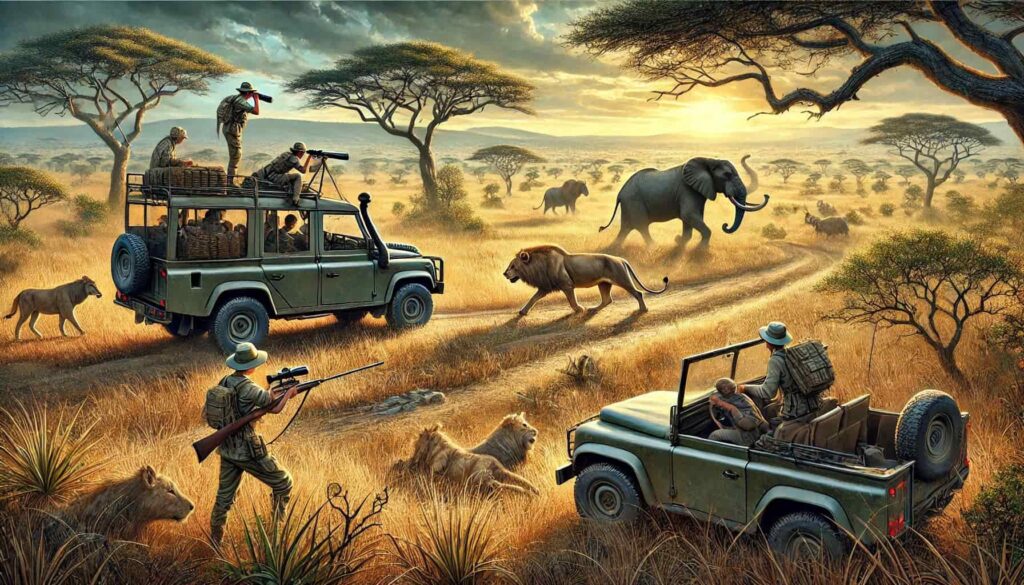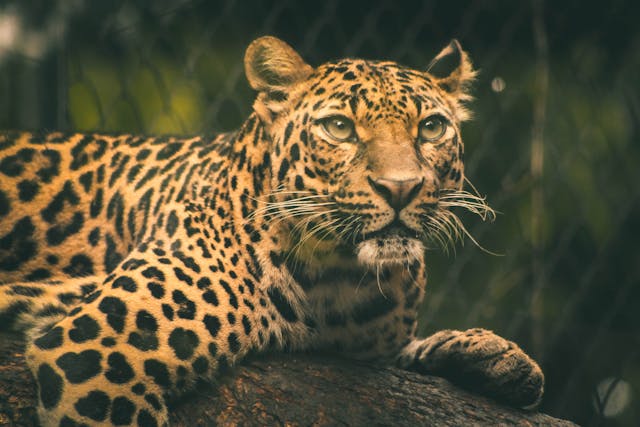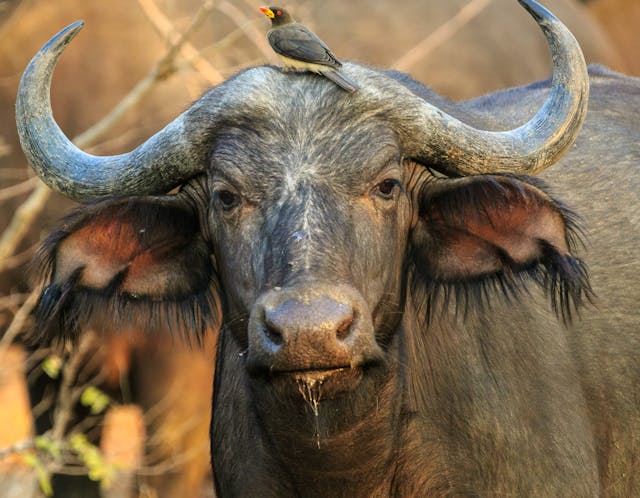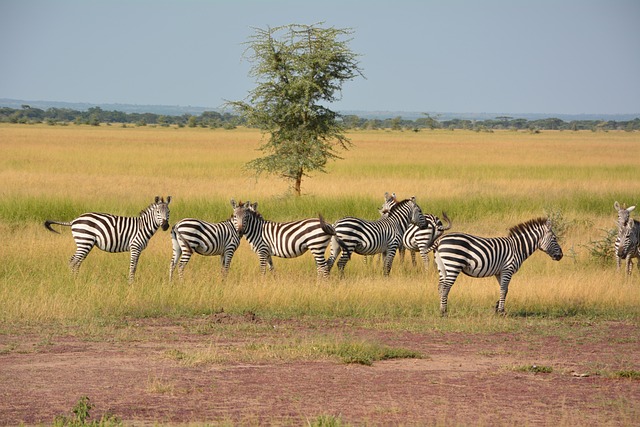
Uncommon to African Safari is the Dangerous game hunting, which, by definition entails the gunning down of some of Africa’s largest, most iconic animals, including Elephant, Cape Buffalo, Lion, Leopard, Rhino, Hippo and Crocodile. Getting charged by these animals is not something you will forget in a hurry. Also known as Trophy Hunting, this risky sport is one activity that can get your blood pumping like nothing else. Yet, thousands of people each year still visit wild spaces across Africa with guns in hand. They apply for permits to recreationally hunt big animals.
Although, dangerous game hunting on African safari, is a deeply controversial activity steeped in history, culture, and significant economic impact. The current accepted estimate is that designated wildlife hunting areas, often called conservancies, account for a whopping two-thirds of all of sub-Saharan Africa’s protected areas.
In these dangerous game African safari hunting experiences, lions, leopards, elephants, rhinoceroses, and Cape buffalos, collectively known as the “Big Five” are targeted for trophies, personal accolades, and the thrill of a challenging hunt. Today, however, the ethical, ecological, and social implications of big game hunting fuel intense debate and public scrutiny amid the declining populations of the affected wildlife. On this blog post, you will find all you need to know about this dated tradition.
The History of Dangerous Game Hunting on African Safari
Dangerous game hunting on safari has been a significant aspect of African history, dating back centuries. Early European explorers and colonizers were fascinated by Africa’s diverse wildlife, and hunting expeditions became a symbol of adventure, strength, and prestige. Iconic figures, such as former U.S. president, Theodore Roosevelt, documented their African safaris, popularizing the practice among Westerners and instilling an image of Africa as a land of thrilling wilderness.
The renowned big-game hunter recounted his hunt of a bull rhinoceros in his 1910 book, “African Game Trails: An Account of the African Wanderings of an American Hunter-Naturalist”. A black-and-white image of the aftermath shows Roosevelt in what was a common pose for him: standing alongside the lifeless body of a creature that he had hunted and killed.
During colonial times, European hunters introduced formal game laws to regulate the hunting industry. These laws initially focused on maintaining hunting as an exclusive activity for wealthy tourists and aristocrats. However, as conservation concerns grew, hunting regulations became stricter. A hundred years later, African countries have since inherited these regulations and adapted them to fit contemporary conservation needs.
Top Dangerous Game Animals in Africa
Trying to outwit incredibly cunning predators and African game animals like the following is quite an exciting and true mind game. The “Big Five Hunting” refers to the lion, leopard, African elephant, rhinoceros, and Cape buffalo, so named not only for their size but also for the challenge and danger involved in hunting them. Each of these animals presents unique difficulties and challenges for even professional hunters:
Lion: The King of the Jungle

Renowned as the “king of the jungle,” lions are powerful predators that, when threatened, can attack with surprising force and aggression. Lion hunting is often the pinnacle moment in any hunter’s career. There is something truly unique and special about pursuing lions that really captures the essence of Africa and the true definition of “dangerous game”. They can either be hunted either by using the baiting method, or by the tracking method.
As with all dangerous game hunts, shot placement is important when hunting lions. A good quality soft .30 calibre will easily kill both a lion. They are not thick-skinned and are susceptible to hydrostatic shock, sometimes dying immediately with a well-placed bullet. They are extremely dangerous when wounded, so make sure your first shot counts. Most places require a .375 minimum for all dangerous games; the bigger, the better, as long as accuracy is not sacrificed.
To hunt a lion, you will approach slowly and circle around the lion until you have the wind in your favour and the sun from behind. Get closer to about 25-30 yards from the lion and position yourself on a clear shot. Your professional hunter will put up the shooting sticks and instruct you to take aim and wait. As soon as you, your professional hunter and your backup shot are ready and everyone’s sights are locked on the lion, the professional hunter will tell you to relax, take a deep breath and shoot when ready. At this point, the lion is ready to charge at any minute and has his sights locked on you. Remember shot placement is everything at this point. Adrenalin will be pumping as never before and it is now up to you to lock your scope onto the lion and pull the trigger.
Leopard: The Elusive and Stealthy Predator

Elusive and nocturnal, leopards are difficult to track and are incredibly too powerful for their size. They are known for their agility and stealth, making them dangerous adversaries if surprised. Accuracy is very important for leopard hunting. Shots are typically 50-70 yards and are from a set position. You will have one shot. More often than not, a wounded leopard will charge.
Leopards can either be hunted by a blind or with a dog. Built on active bait, a blind location is dictated by terrain and wind direction.
Hunting with dogs improves a hunter’s chances of getting the game especially if carried out before September. This is because dogs can smell better in slightly wet grass.
The first step is to hang baits and to try and pick up fresh tracks and leopard activity. Your hunts will then start around 3 am in the mornings looking for fresh tracks. Once found, dogs will be released and it is now up to the dog handler and his pack of dogs to find the leopard. Hunters need to be able to at least walk/jog at a good pace so they can catch up to the dogs once the dogs have bayed the leopard.
Elephant: The World’s Largest Land Animal

African elephant, the world’s largest land animal, has an unpredictable nature. Elephants living in the wild are known to be extremely dangerous and can be very aggressive when confronted, especially in thick brush when calves are present. With their massive tusks and weight as lethal weapons, the idea of simply “walking in and shooting an elephant” approximates wishful thinking.
Elephant hunting is done mostly on foot by following promising fresh spoor until the animal is sighted. It is then determined if the tusks are of satisfactory trophy size. Usually, this type of hunting involves hours of walking only to be disappointed by a large bodied small tusked bull.
Generally, older, larger bulls will have younger, more alert bulls in attendance, and they often raise the alarm or cause problems by always seeming to be in the way of the path of the larger bull. In most cases, an Elephant hunt is a psychological battle of endurance, patience and persistence, with many blisters, sunburn and exhaustion.
The shooting part of the hunt is fairly quick, usually a brain shot is recommended at close quarters with heavy grain solids from a large bore calibre. When facing the Elephant a frontal brain shot is aimed at the third or fourth wrinkle below the center of the eyes. With a side shot, aim for the area between the eye and the ear hole or directly in front of the ear hole where the hairy knob juts out. A heart shot is a better bet when it is difficult to get in close to the elephant, placed lower down, directly behind the shoulder.
Rhinoceros: The Endangered Giant

This massive creature forages twigs, leaves, succulents, herbs, and branches for its food, grasping them with its pointed upper lip. The Rhinos, also known as the hook-lipped rhino, prefer habitats including savannas, thickets, and open plains. Rhinos are an incredible sight to behold in the wild. Unfortunately, due to illegal poaching and hunting of this tough member of the Big 5, it is now critically endangered. They have poor eyesight but an acute sense of smell and hearing, making them unpredictable and prone to charging if they feel threatened. Their thick skin and large horns make them challenging targets.
As with all the big five dangerous game hunting, the minimum legal requirement for rhino hunting in Africa is a .375 caliber shooting a 300-grain bullet. Another consideration is a well-placed bullet from a 416 Rigby, 500 Jeffery, 458 WM, or Lott which will all ensure proper penetration of its incredibly tough hide. Some hunters may prefer double rifles such as the 470NE, 500NE, and higher, especially in close quarters on this dangerous game hunting safari.
The challenge of rhino hunting is firstly to approach it, as it has very good hearing and sense of smell. Secondly, it has a very thick skin to penetrate. For many hunters, simply being on a dangerous game hunting safari targeting this spectacular mammal is sufficient. Overall, it is priceless to have the opportunity to test your hunting prowess against that of one of the Big 5!
Cape Buffalo: The Notorious “Black Death”

Nicknamed “the Black Death,” the Cape buffalo is known for its aggressive behavior and is considered by many hunters as the most dangerous of the Big Five. Injured buffalo are notorious for circling back and charging at hunters.
Cape Buffalo are herd animals concentrated on the open Savannah where grazing and water are plentiful. They tend to graze from early evening into the night and then the cooler parts of the day, seeking shaded cover as it gets hotter. Their eyesight and hearing is quite poor but their sense of smell is excellent. It is much harder to get close to a herd of buffalo than solitary bulls.
Cape Buffalo are hunted on foot, which makes this hunt extremely exciting. You will start out by scouting for fresh tracks or fresh Buffalo dung, that are normally found at waterholes or on gravel roads on the area. The best shot placement for buffalo is to hit vital organs, hopefully breaking bone somewhere in the process. If hit properly, the animal will grunt at impact and take off at a gallop, usually signalling death with a characteristic bellow. But if in a herd, the wounded animal usually breaks away and heads to thick cover.
The foregoing are the dangerous animals to hunt, serving as trophies for hunters willing to take on the risks involved. However, this trophy doesn’t come without significant controversy and ethical concerns.
Ethical Considerations in Dangerous Game Hunting on African Safari
Hunting conservation debate has remained a complex issue, with the call for a ban coming from diverse quarters. For some critics, there is a moral objection to the killing of wild animals for pleasure, for others an understandable emotional response to images of hunters posing with their kills or concerns over conservation.
Pro-hunting proponents argue that hunting provides revenue that directly funds conservation and delivers financial incentives for locals to protect wildlife, eliminating the human-wildlife conflicts that come from communities losing a key source of income. Anti-hunters maintain that neither this nor any amount of revenue or conservation funding can justify the killing of animals for pleasure.
Ethical hunting in Africa borders on the following:
- Animal Welfare – Animal rights advocates assert that hunting is an outdated practice that causes unnecessary suffering and commodifies wildlife. While trophy hunters argue that kills are quick and humane, incidents of wounded animals suffering or being inadequately tracked are common. Critics argue that these practices are unethical and violate the principles of animal welfare.
- Moral Conflicts in Killing Iconic Species – The notion of killing iconic and endangered animals, such as elephants and lions, raises moral objections for many people. Critics contend that such practices send the wrong message about conservation, implying that animals are worth more dead than alive.
- Alternatives to Hunting – Opponents of dangerous game hunting propose alternatives such as eco-tourism, photographic safaris, and wildlife-viewing experiences as non-lethal options for generating income. These alternatives, they argue, offer the same economic benefits without compromising animal lives. However, proponents of hunting counter that not all areas are suitable for ecotourism and that hunting may still provide a more stable and higher revenue stream in some regions.
Impact of Dangerous Game Hunting on Wildlife Conservation
One of the primary arguments in favour of dangerous game hunting is its role in wildlife conservation. This is a significant portion of revenue from hunting is channeled into conservation. Adherence to trophy hunting ethics can still yield revenues that can bankroll laudable programs like anti-poaching operations, habitat protection, and research initiatives. Conservation hunting in Africa has made the following impacts on African safari:
- Population Control – In cases where animal populations have exceeded the carrying capacity of the land, regulated hunting can help maintain balance within the ecosystem. For example, the overpopulation of elephants in certain regions can lead to overgrazing and environmental degradation, endangering other species and damaging local agriculture. In such cases, limited hunting can serve as a management tool.
- Reducing Human-Wildlife Conflict – In areas where large, dangerous animals like elephants and lions come into close contact with human populations, hunting can be a way to manage human-wildlife conflict. When animals pose a threat to human lives or livestock, limited hunting can alleviate local hostility toward wildlife and reduce retaliation killings.
- Encouraging Private Conservation – Dangerous game hunting has incentivized the creation of private game reserves, which play an important role in wildlife conservation. Many of these reserves, particularly in South Africa, are funded through hunting revenue. The presence of hunting as a profitable enterprise encourages landowners to maintain wilderness areas, rather than converting the land for agriculture or other purposes that would displace wildlife.
- Funding Anti-Poaching Efforts – Poaching remains one of the biggest threats to African wildlife. Funds from dangerous game hunting help finance anti-poaching operations, which are essential to safeguarding endangered species. These funds are used for hiring rangers, purchasing equipment, and supporting surveillance efforts aimed at preventing illegal hunting and trafficking.



0 Comments